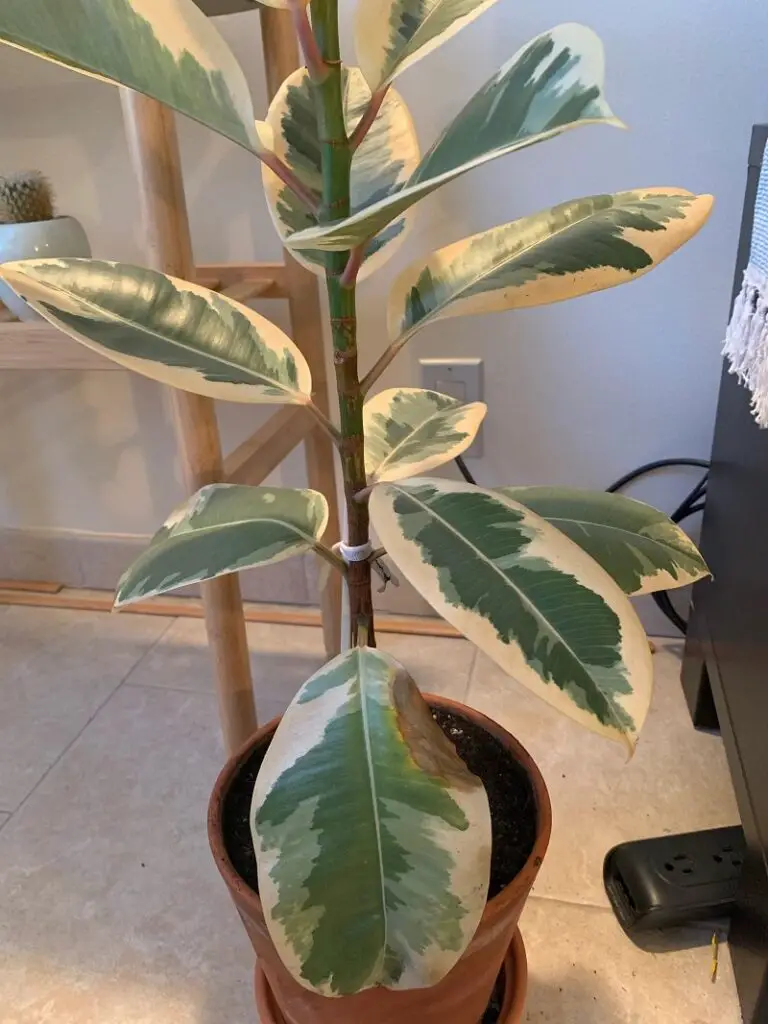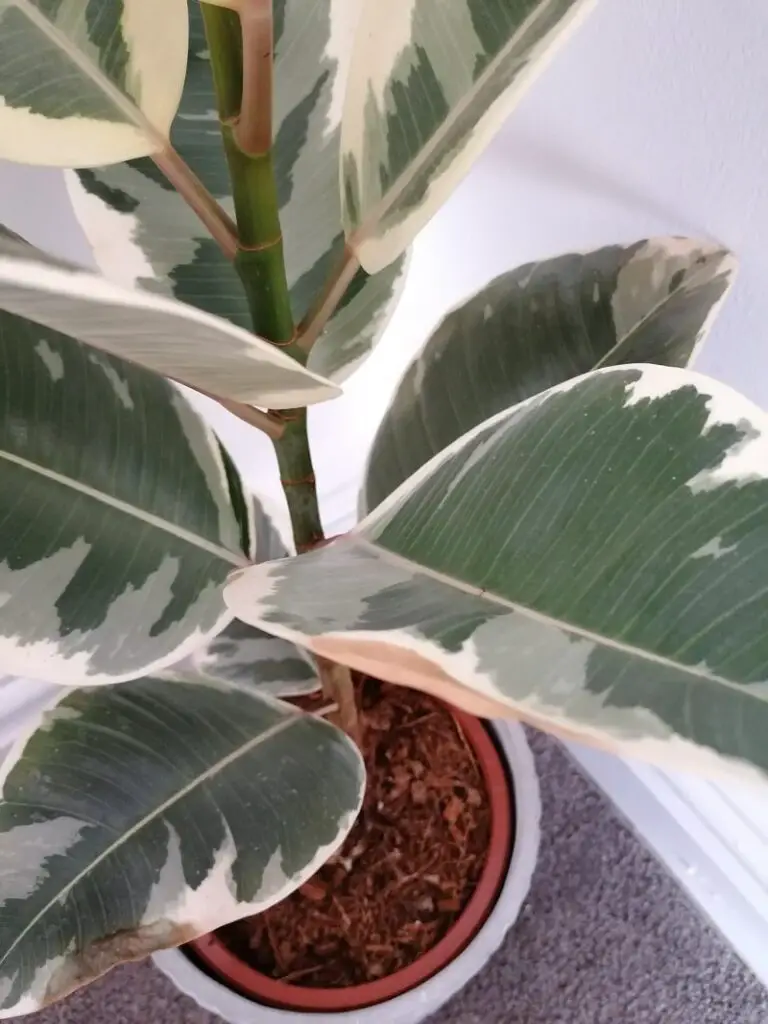Rubber plant (Ficus Elastica) is a classic indoor plant. Thanks to its bold and distinctive leaves that mark a statement in any space. But rubber plant leaf problems are inevitable due to the dynamics with indoor growing conditions.
So, why are my rubber plant leaves turning brown? Potential causes are direct sunlight exposure, improper watering, old foliages, low humidity, temperature stress, over-fertilization, water impurities, inappropriate soil mix, and pest infestations.
Rubber plants can grow into immense trees in the ground outdoors. The leaves are usually bold and rugged at the juvenile stage. These leaves later shrink at maturity. Proper variegated rubber plant care helps to bring out that tropical vibes in the house.
Keep reading this article to know the reasons behind the rubber plant leaves turning brown. The guide will also help you learn how to fix brown leaves on rubber plants.
You May Also Like: Why Is My Calathea Dying?

10 Causes of Rubber Plant Leaves Turning Brown
Overwatering
Rubber plants are more vulnerable to the effects of overwatering. The issue is prevalent in winter when the plant does not require much moisture.
Besides that, overwatering occurs due to improper soil drainage. The damp environment makes the rubber plant develop root rot disease.
The root rot disease affects the health and appearance of the plant. The damaged roots fail to undertake water absorption in the long run.
Rubber plant leaves turning brown and wilting are indicators of dehydration. If the condition persists for an extended period, reviving the houseplant will be challenging.
The best solution is to re-pot the rubber plant. Unpot it and inspect any signs of root rot. Use a sterilized pruner to cut the affected roots. Transplant the rubber plant to a fresh potting mix.
Under-Watering
An inconsistent watering habit is another possible cause of rubber plant leaves turning brown and becoming crispy. Insufficient water has a high chance of killing your rubber plant.
Other signs of underwatered rubber plants are leaves curling, drooping, and turning yellow. The potting mix will also appear drier.
Try to soak the soil with plenty of water until it runs through the drainage holes. Be sure to provide ultimate variegated rubber plant care for better growth and appearance.
Plant Diseases
Rubber plants are less vulnerable to common plant diseases. But that does not mean the houseplant is invincible to diseases.
Fungal infection is the potential cause of rubber plant leaf problems. The condition causes leaf discoloration or mottling and browning if not treated early.
The ailment is also characterized by white deposits on the leaves. Fungal infection occurs more often in wet conditions, and it is not fatal to the plant.
Trim the affected leaves and water the plant carefully to combat the infection. Remember to isolate the houseplant from others to prevent the spread of the disease.
Direct Sunlight Exposure
Rubber plants are native to the tropical rainforest. These plants thrive under the canopy. Overexposure to direct sunlight may give the leaves scorch spots or brown patches.
These brown patches reduce the tropical vibes of the plant. Be sure to be attentive to the changing weather and protect your rubber plant from direct sunlight.
Relocate the current position of the plant to where it will receive bright indirect sunlight. Keep in mind that the rubber plant leaves will droop on a hot afternoon.
Pests Infestation
Pest infestations usually deform the leaves and turn them brown. But rubber plants are less susceptible to insect infestation.
But my rubber plant seems to attract scales. These insects tend to damage the vital leaf tissues by poking to suck the cell-sap. The entire leaves end up develops tiny brown spots.
Establish a routine of cleaning and inspecting the rubber plant leaves more often. It helps to prevent insect infestations and keep the leaves glossy.
If your rubber plant leaves are infested by scales, try to wipe them with isopropyl alcohol. It helps to eliminate the insects and keep the leaves healthy.
Temperature Stress
Rubber plant thrives in a warm climate. The best indoor temperature for growing rubber plants during the day is about 60-65oF and 75-80oF at night.
When the temperature goes up to 80oF during the day, the rubber plant leaves will begin to droop, turn brown, and eventually dies.
Maintaining the standard temperature requirement in the house will help prevent the rubber plant leaves from turning brown. Install digital thermometer to detect the temperature changes.
Fertilizer Problem
Rubber plants are not heavy feeders. But the application of fertilizer helps to foster proper growth and better foliage development.
Too much fertilizer around the roots tends to be toxic to the plant. The condition inhibits the roots from absorbing water to keep the plant hydrated.
Rubber plant leaves turning brown is a sign of dehydration. Consider flushing the potting mix with plenty of water to get rid of excess fertilizer.
Insufficient nutrients in the soil will also result in stunted growth and brown edges on the leaves. I recommend using homemade fertilizer over artificial counterparts.
Poor Air Circulation
Improper air circulation in the house enhances fungal growth and insect infestation. These factors later result in rubber plant leaves developing brown spots or patches.
Be sure to select the best place in the house that experiences better air circulation. It will help to prevent fungal growth and pest infestation.
Lack of Humidity
Rubber plant thrives in average humidity. The houseplant can also tolerate drier air for a shorter period without becoming fussy.
Low humidity in the indoor environment will the rubber plant leaves to turn brown along the edges and tips. The dry air encourages the plant to lose more water than what is being absorbed.
Consider raising the indoor humidity by installing an electric humidifier. Ensure the humidity ranges from 25% to 50%.
Natural Aging
Aging is inevitable among plants and animals. Old leaves usually turn brown and fall off. But if the condition becomes more frequent and affects multiple leaves, it is a sign of a serious issue.
Lower leaves are the oldest and tend to fall off. It is a natural process, and there is no need to raise concerns. It allows the plant to redirect the energy to new growths.
Related Questions
Why Is My Rubber Plant Leaves Turning Yellow?
Rubber plant leaves turning yellow is due to lack of nutrients, low lighting conditions, overwatering, and under-watering. Other possible causes are pests and diseases.
Why Is My Rubber Plant Leaves Curling?
Rubber plant leaves curling due to temperature stress, low humidity, under-watering, and pest infestations. Other potential causes are direct sunlight exposure and overwatering issues.
Why Is My Rubber Tree Leaves Turning Black?
Rubber tree leaves turning black due to fungi, mold, bacteria, and viral diseases. These black spots on rubber plants occur due to excessive watering.
Why Is My Rubber Tree Leaves Turning Orange?
Rubber tree leaves turning orange are due to insufficient minerals in the soil. Consider applying mineral-rich fertilizer to your rubber plant.
Should I Cut Brown Leaves off Rubber Plant?
Yes. Pruning helps the rubber plant redirect the energy to the new growths. Be sure to wear gloves and cover the floor with newspaper for maximum protection from cell-sap. (Best Garden Gloves Deal on Amazon)

In Conclusion
Rubber plant leaves turning brown can be a freaking concern. The rule of thumb is to identify the possible cause and devise ways of fixing the issues.
Low humidity, temperature stress, sunburn, and inconsistent watering are the potential cause of rubber plant leaves turning brown.
I hope the information in the article will be useful to enhance ultimate variegated rubber plant care. These tips will help avoid possible rubber plant leaf problems.
